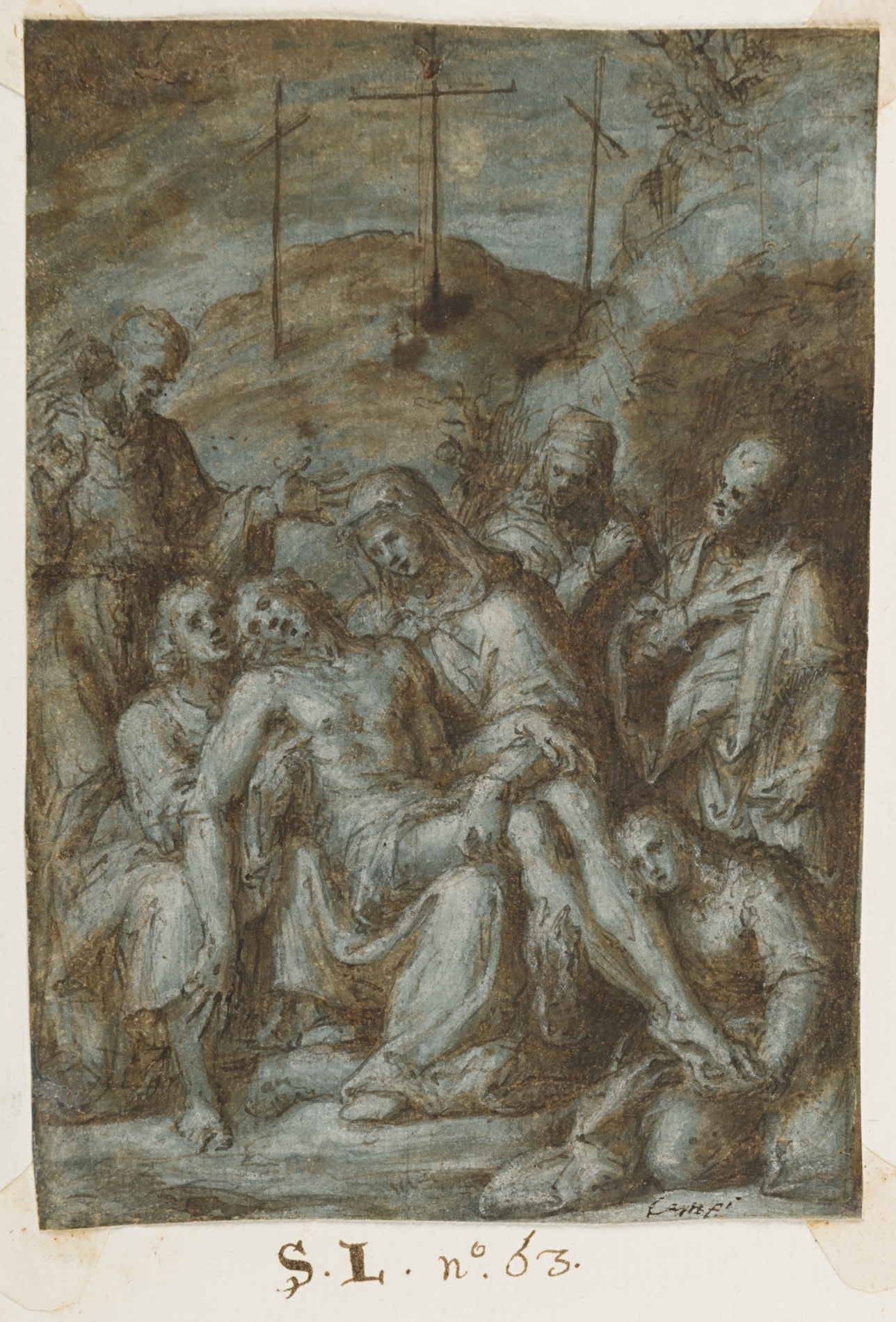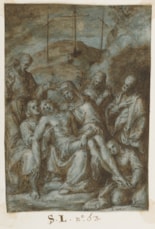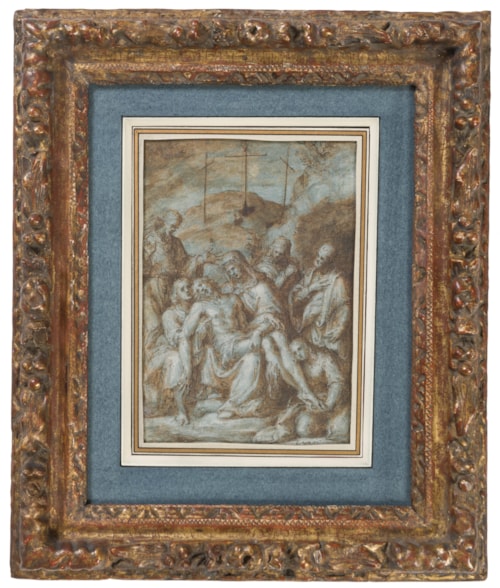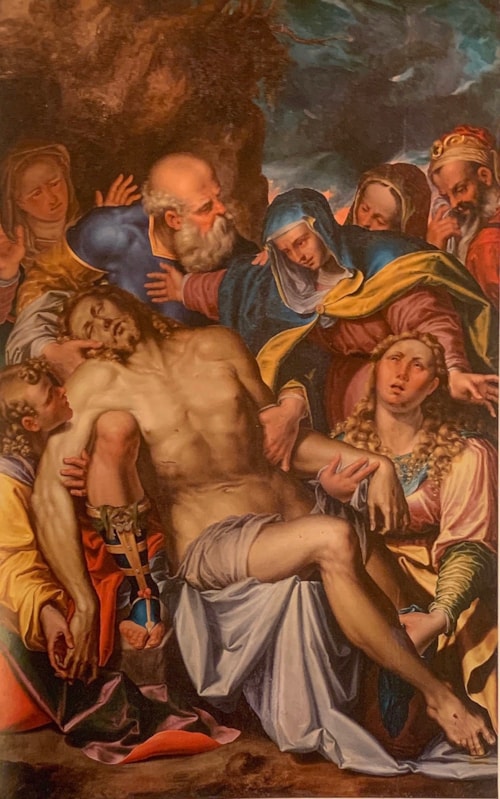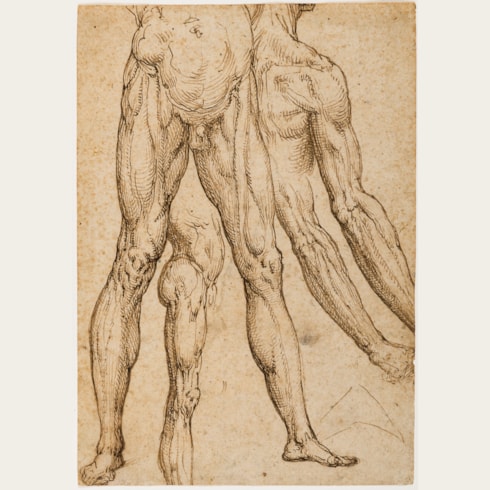Aurelio LUINI
(Milan c.1530 - Milan 1593)
The Lamentation over the Body of Christ
Pen and brown ink and brown wash, heightened with white, on paper washed blue.
Inscribed Campi at the lower right.
Further inscribed S.L. no. 88 on the backing sheet, and S.L. no. 63. in the lower margin of the album page to which the drawing is attached by four corner tabs.
174 x 120 mm. (6 7/8 x 4 3/4 in.)
Inscribed Campi at the lower right.
Further inscribed S.L. no. 88 on the backing sheet, and S.L. no. 63. in the lower margin of the album page to which the drawing is attached by four corner tabs.
174 x 120 mm. (6 7/8 x 4 3/4 in.)
This finished compositional study was first attributed to Aurelio Luini by the late Mario di Giampaolo in 2002. The scene takes place on Golgotha, or Calvary, in the tenebrous aftermath of the Crucifixion. Christ’s lifeless body is supported by the Madonna, Mary Magdalene, and Saint John the Evangelist, while Joseph of Arimathea, Nicodemus, and a holy woman have gathered around them in prayer. The drawing shows Aurelio approaching the final scheme of what was certainly to be an altarpiece. The artist has already decided upon the overall arrangement and the reciprocal interactions of the figures and here sets the scene’s emotional tone. The evident similarities with Aurelio’s altarpiece of Lamentation over the Dead Christ, painted around 1575-1580 for the church of Santi Paolo and Barnaba in Milan and still in situ there – in particular, the Saviour’s expanded torso, reclining head, and the pose of his right arm – might suggest that the artist made this drawing in preparation for that painting, before deciding to simplify the composition and reduce the number of figures. If so, it would have been followed by another, variant, modello, similar in nature to the present sheet. Alternatively, this study might have been made for a different Lamentation that has yet to surface; indeed, numerous paintings by Luini remain to be discovered.
Luini’s graphic oeuvre includes various drawings which concentrate on the iconography of the Pietà, notably a study for a Lamentation at the Foot of the Cross in the Royal Collection at Windsor Castle, and a Lamentation in the Gallerie dell’Accademia in Venice, both of which were probably made for the SS. Paolo and Barnaba Lamentation. Another stylistically and thematically comparable drawing of the Pietà by Luini, also on blue prepared paper, appeared at auction in 1993 and is today in the Museo Soumaya (Fundación Carlos Slim) in Mexico City; that drawing focuses on the Mater Dolorosa theme and includes only the mourning Virgin and the Dead Christ.
The present sheet is striking for its bold painterly effects. Aurelio Luini achieved this by delineating his scheme in pen and ink and then superimposing subtle layers of brush and brown wash. The use of blue prepared paper, which is typical of the artist’s mature work, emphasises the atmospheric effect of the sacred event and recalls Aurelio’s penchant for Venetian art, the influence of which is very clear in the SS. Paolo and Barnaba Lamentation. Other drawings by Luini on similarly prepared blue paper are in the J. Paul Getty Museum in Los Angeles and the Accademia in Venice.
This splendid drawing was once part of what was arguably the finest collection of drawings assembled in Venice in the early 18th century, that of Zaccaria Sagredo (1653-1729). The collection amounted to several thousand drawings contained in over fifty albums, and the present sheet retains the four corner tabs with which each drawing was attached to its album page, together with the associated numbering and inscription - in this case ‘S.L.’, for ‘Scuola Lombarda’ – that was written on every sheet in the Sagredo collection.
Although the collection had been begun by his uncle, Doge Niccolò Sagredo, in the middle of the 17th century, it was the Venetian nobleman Zaccaria Sagredo who was responsible for greatly expanding it. As Roger Rearick has noted, ‘Zaccaria was the most voracious of the Sagredo collectors, purchasing numerous drawings from every school and period, and making the Sagredo collection one of the most distinguished and certainly among the largest cabinets in Italy prior to his death in 1729.’ Zaccaria bequeathed the collection to his nephew and heir, Gherardo Sagredo (1692-1738). At the latter’s death in 1738, an inventory of the collection noted some 8,000 drawings, as well as more than 22,000 prints. Gherardo’s widow, Cecilia Grimani Sagredo (b.1686), tried to sell the collection en bloc but was only able to dispose of parts of it, while the rest was inherited by her two daughters. At some point in the late 18th or early 19th century some of the Sagredo drawings were acquired by a collector in Lyon, possibly the artist Jean-Jacques de Boissieu (1736-1810). The present sheet is likely to have been among the large group of drawings from the Sagredo collection that were dispersed in Lyon just after the First World War.
Luini’s graphic oeuvre includes various drawings which concentrate on the iconography of the Pietà, notably a study for a Lamentation at the Foot of the Cross in the Royal Collection at Windsor Castle, and a Lamentation in the Gallerie dell’Accademia in Venice, both of which were probably made for the SS. Paolo and Barnaba Lamentation. Another stylistically and thematically comparable drawing of the Pietà by Luini, also on blue prepared paper, appeared at auction in 1993 and is today in the Museo Soumaya (Fundación Carlos Slim) in Mexico City; that drawing focuses on the Mater Dolorosa theme and includes only the mourning Virgin and the Dead Christ.
The present sheet is striking for its bold painterly effects. Aurelio Luini achieved this by delineating his scheme in pen and ink and then superimposing subtle layers of brush and brown wash. The use of blue prepared paper, which is typical of the artist’s mature work, emphasises the atmospheric effect of the sacred event and recalls Aurelio’s penchant for Venetian art, the influence of which is very clear in the SS. Paolo and Barnaba Lamentation. Other drawings by Luini on similarly prepared blue paper are in the J. Paul Getty Museum in Los Angeles and the Accademia in Venice.
This splendid drawing was once part of what was arguably the finest collection of drawings assembled in Venice in the early 18th century, that of Zaccaria Sagredo (1653-1729). The collection amounted to several thousand drawings contained in over fifty albums, and the present sheet retains the four corner tabs with which each drawing was attached to its album page, together with the associated numbering and inscription - in this case ‘S.L.’, for ‘Scuola Lombarda’ – that was written on every sheet in the Sagredo collection.
Although the collection had been begun by his uncle, Doge Niccolò Sagredo, in the middle of the 17th century, it was the Venetian nobleman Zaccaria Sagredo who was responsible for greatly expanding it. As Roger Rearick has noted, ‘Zaccaria was the most voracious of the Sagredo collectors, purchasing numerous drawings from every school and period, and making the Sagredo collection one of the most distinguished and certainly among the largest cabinets in Italy prior to his death in 1729.’ Zaccaria bequeathed the collection to his nephew and heir, Gherardo Sagredo (1692-1738). At the latter’s death in 1738, an inventory of the collection noted some 8,000 drawings, as well as more than 22,000 prints. Gherardo’s widow, Cecilia Grimani Sagredo (b.1686), tried to sell the collection en bloc but was only able to dispose of parts of it, while the rest was inherited by her two daughters. At some point in the late 18th or early 19th century some of the Sagredo drawings were acquired by a collector in Lyon, possibly the artist Jean-Jacques de Boissieu (1736-1810). The present sheet is likely to have been among the large group of drawings from the Sagredo collection that were dispersed in Lyon just after the First World War.
The youngest son of the Milanese painter Bernardino Luini, who died when he was an infant, Aurelio Luini nevertheless worked in his father’s tradition as a pupil and one of the most accomplished followers of Leonardo da Vinci. Like his father, Aurelio worked throughout his life in and around his native city of Milan, often in collaboration with other local artists. Together with his brother Giovan Pietro, he was tasked with completing some of the fresco decoration begun by their father Bernardino in the Milanese church of San Maurizio al Monastero Maggiore. In this cycle of scenes from the life of Christ, his first major independent work, Aurelio’s forms retain his father’s characteristic softness and chiaroscuro. Many of the younger Luini’s commissions came from religious societies, and his work can be found in several churches in Milan, including San Simpliciano and the Duomo. He also produced numerous fresco cycles in the city and throughout Lombardy and Piedmont, notably in the church of Santa Maria di Campagna in Pallanza, on Lake Maggiore, where he worked alongside the painter Carlo Urbino. Among Luini’s final and most significant works were the now-lost frescoes of scenes from the life of Saint Ambrose for the vault of a chapel in the Tribunale di Provvisione in Milan, completed a few weeks before his death in 1593. As well as being a painter, Luini also composed music and poetry, and was himself the subject of a sonnet written by artist and theorist Giovan Paolo Lomazzo, who regarded him as the most gifted of Bernardino’s Luini’s three sons: ‘Evangelista and [Giovan] Pietro [Luini] are equal in painting, but you are more worthy, Aurelio, whose mind has higher aspirations, as one can see and admire in your work. Besides, with the lyre singing sweetly you reveal your thoughts and your drawings in ornate and worthy verses.’
Aurelio Luini was a talented draughtsman, and the only one of the three Luini brothers to have a recognizable drawing style. One contemporary source, writing two years after Aurelio’s death, noted of him that ‘Il Louino fù gran disegnatore, & acurato pittore, e versato in molte altre honorate virtù, il che universalmete era amato da tutti, e nella pittura fù vero imitatore del padre.’ He tended to work in pen and ink, sometimes with wash on blue paper, with a confident and nervous manner. Drawings by Luini are fairly rare, and only some two hundred are known.
Aurelio Luini was a talented draughtsman, and the only one of the three Luini brothers to have a recognizable drawing style. One contemporary source, writing two years after Aurelio’s death, noted of him that ‘Il Louino fù gran disegnatore, & acurato pittore, e versato in molte altre honorate virtù, il che universalmete era amato da tutti, e nella pittura fù vero imitatore del padre.’ He tended to work in pen and ink, sometimes with wash on blue paper, with a confident and nervous manner. Drawings by Luini are fairly rare, and only some two hundred are known.
Provenance
From the so-called ‘Sagredo-Borghese’ collection, with associated inscriptions S.L. no. 63 and S.L. no. 88 (for ‘Scuola Lombarda’), and with provenance as follows:
Zaccaria Sagredo, Venice (Lugt 2103a)
By descent to his nephew, Gherardo Sagredo, Venice
His widow, Cecilia Grimani Sagredo
Thence by descent
Dispersed in a series of sales after 1743
Probably Jean-Jacques de Boissieu, Lyon
Probably dispersed with some of the Sagredo albums in Lyon in 1919
Thomas Williams Fine Art, London, in 2002
Herbert Kasper, New York
Thence by descent.
Zaccaria Sagredo, Venice (Lugt 2103a)
By descent to his nephew, Gherardo Sagredo, Venice
His widow, Cecilia Grimani Sagredo
Thence by descent
Dispersed in a series of sales after 1743
Probably Jean-Jacques de Boissieu, Lyon
Probably dispersed with some of the Sagredo albums in Lyon in 1919
Thomas Williams Fine Art, London, in 2002
Herbert Kasper, New York
Thence by descent.
Literature
Jordan Bear et al, Mannerism and Modernism: The Kasper Collection of Drawings and Photographs, exhibition catalogue, New York, 2011, pp.66-67, no.17 (entry by Aimee Ng).
Exhibition
London, Thomas Williams Fine Art Ltd., Old Master Drawings, 2002, no.2; New York, The Morgan Library and Museum, Mannerism and Modernism: The Kasper Collection of Drawings and Photographs, no.17.

